High -Accuracy Hand -Held Lactate-Analyser |
||
|
|
||
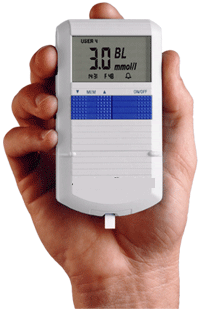 |
||
|
Lactate is the unique metabolic variable that indicates the capability of the muscles for an athletic performance. We emphasize "unique" in the preceding sentence because no other metabolic parameter provides the same information. The ability of the muscles to reach a peak performance during an athletic event requires that the systems providing energy be "fine tuned" or "balanced" properly so that the athlete can generate the highest amount of energy per unit of time during a race. Proper training is what accomplishes this fine tuning or optimal balance and it is lactate testing that lets the coach know if the balance has been obtained or how each energy system must be trained in order to obtain the balance. Coaching is a profession requiring both art and science. The building blocks for an optimal performance are many and must be constructed in a proper sequence and must recognize that each individual is different. Some of these building blocks are correct technique, positive mental attitude and a proper diet. However, the cornerstone for this building is precise physiological training. That is the main reason an athlete spends so much time in the water, on the bike, on the track or the road, in the weight room or wherever training is best conducted. Ask yourself, do you know if all those miles/hours of training are paying out? But what is appropriate physiological training? It is not volume or else those who put in the most hours/miles would be the winners. It is not intensity or else those who pushed themselves the hardest would be the winners. It is not someone's favorite workout or else everyone would be copying the magic workout or training pace. It turns out that each individual has their own way of adapting and any smart training plan must recognize this. This is a fact of life. Each has to find his or her own way to the proper balance of the energy systems and peak conditioning on the day that counts, race day. With proper protocols the / Lactate hand-held Lactate Analyzer enables the coach to measure both the aerobic and anaerobic conditioning of each athlete. Information about both is necessary for the coach to optimize the conditioning of each athlete whether they are a 50 meter freestyle swimmer (about 22 seconds plus per race) or an Ironman triathlete (over 8 hours per race). With information on each energy system the coach can plan, control and monitor the training of athletes with a precision not available before. The / Lactate provides the important information that enables the coach to individualize the intensity of each athlete's workout and control their training so they reach performance objectives. No over-training and no surprises come race day. How does Lactate Testing do this?Provides a multi-dimensional profile of conditioning. Because lactate is produced by the anaerobic system and used by the aerobic system it is the only marker available for measuring each system. The amount of energy an athlete can produce per unit of time depends on the development of both systems which is why they have to be balanced. (Essentially this means training the anaerobic system to a level that is appropriate for the athlete's aerobic capacity.) This balance will depend upon the event for which the athlete is competing and will also depend upon which part of the training cycle the athlete is in. The closer the athlete gets to the "big" event the balance will have to be "fine tuned" for a peak performance. Show adaptation in each system. Over time changes in blood lactate levels tell the coach what physiological adaptation has taken place in each system. It tells the coach which forms of training are working or not working. Training time becomes much more efficient as the athlete performs only workouts that work. The / Lactate becomes a "training compass" that "steers" each athlete in the right direction. It is much more relevant than heart rate monitoring which reflects a general overall body response to stress and doesn't necessarily reflect what is happening in the muscles or with the anaerobic system. It is much more versatile than VO2 testing which requires very expensive equipment and doesn't tell you much about the anaerobic system. Teaches coaches and athletes what is required for a peak performance. Lactate testing is also a learning and motivating experience for coaches and athletes as they become much more aware of the interactions of variables and the other nuances that affect workouts as well as performance. Since the emphasis will be on training energy systems and not the use of very broad training zones, coaches will understand what works best for each energy system and why, what may be counter-productive and when and in what sequence various types of training are appropriate. The Best Information in the World on Lactate TestingLactate Testing Information for the coach. The Secrets of Lactate CD-ROM was written for the coach.and is anything but trivial. There are 16 tutorials on different aspects of lactate testing, metabolism, interpretation with in-depth discussions in three sports. In addition there are 8 extensive discussions on various topics such as the anaerobic threshold, heart rates, proper testing protocols. There is a new interactive module on exercise metabolism which animates how the body's energy systems respond to various races and training exercises. The CD-ROM is the most complete discussion of lactate testing in the world. If you click on the link above or the image below you will see a more detailed discussion that also provides links to sample slides in the tutorials.
Training information for the coach. Probably the two best books in the world for explaining the science of training are Jan Olbrecht's The Science of Winning (published October 2000) and Ernie Maglischo's Swimming Fastest (published January 2003). These are two scientists who have spent their lives with athletes as opposed to academia. Both have Ph.D's in exercise science but don't live in academic ivory towers. Jan works with top athletes in Europe such as world champions Luc van Lierde and Pieter van den Hoogenband while Ernie has coached several NCAA champion teams and swimmers. These two books are wonderfully clear and offer different perspectives from most on what it takes to maximize performance. Another great book is the Physiological Tests for Elite Athletes written by the Australian Sports Commission. Here is a description of how the most successful sports program in the world is testing their athletes in 17 internationally recognized sports. See all our books and CD's on training and testing in The Best Sources on Lactate in the World. |
|
|
Purchase one of our testing packages and get:
|
| System | 1. / Lactate hand-held Lactate Analyzer 2. BM Lactate Test Strips |
| Measuring Principle | Enzymatic determination and reflectance photometry (wavelength 660 nm) of lactate in sample of whole blood. System reads lactate levels in plasma portion of whole blood. |
| Validation Process | Instrument has been tested using guidelines of the European Committee for Clinical Laboratory Standards (tested at 9 separate sites) and cleared for sports medicine use by Federal Drug Administration in the United States (tested at 3 separate sites). Results of these tests are in the Accuracy section.. |
| Result Presentation | Values can be displayed as whole blood or plasma. The instrument converts plasma readings to whole blood values by means of an internal conversion factor. |
| Measuring Range | Whole Blood Mode: 0.8 mmol/l - 22 mmol/l Plasma Mode: 0.7 mmol/l - 27 mmol/l |
| Sample site | Fingertip or earlobe. | Sample Preparation | Unmeasured drop of fresh capillary whole blood (15-50µl) is applied to lactate test strips. Ideal levels are a large hanging drop of blood which is approximately 20-25µl of blood. Some users take blood from earlobe or fingertip using a capillary tube and then pipette the blood to the lactate strip. |
| Alternative Sample Preparation | In laboratory setting venous blood can be used with proper medical supervision. Samples are then pipetted to strip. |
| Measuring Time | Approximately 60 seconds |
| Temperature Range | 5 - 35 C or 41 - 95 F |
| Relative Humidity | 10 - 90% |
| Dimensions | Meter: 4.5 x 2.5 x 0.75 inches (115 x 62 x 18.5 mm) Strip: 1.87 x 0.25 inches (46 x 6 mm) |
| Weight (without batteries) | Approximately 3.75 ounces (100 g) |
| Display | Digital LCD with symbols |
| Power Supply | 3 x 1.5 V batteries, type AAA |
| Memory Capacity | 101 values divided among 6 users. Includes date and time. Maximum 60 values per user. |
| Data Port | 3-pin socket, serial port. Data transfer system available. |
| Lactate Strip Packaging | Lactate strip are packaged in vials of 25 strips. |
| Control Solutions | Two levels: low and high. |
Lactate Strip Description
The Lactate strip consists of four layers (See image below.) These are:- The top layer - this is a yellow mesh where the blood is applied.
- The second layer - this is a glass-fiber layer for separation of the erythrocytes or red blood cells.
- The third layer is a detector film where the chemical reactions takes place. Lactate in the blood plasma reacts with chemicals in this layer.
- The bottom section is a support layer that is the length of the strip.
The reverse side of the strip contains a barcode with the strip lot number and calibrating information. There is also a window exposing the detector film layer to the photometer.
Lactate Determination Process
When a drop of blood is placed on the top layer (yellow mesh), the blood will pass through to the next level. The second layer will then separate the red blood cells and blood plasma will continue to the third layer. A chemical reaction will take place in the detector film resulting in a color change observed by the reflectance photometer. This reaction will take approximately 60 seconds. It is a similar process that millions of diabetics use every day to measure their blood sugar. The chemistry in the strip is different from those strips that doctors and diabetics use to measure blood glucose but the technology is very similar. For instruction on operating the / Lactate analyzer see "How to Use the / Lactate"
Lactate Strip
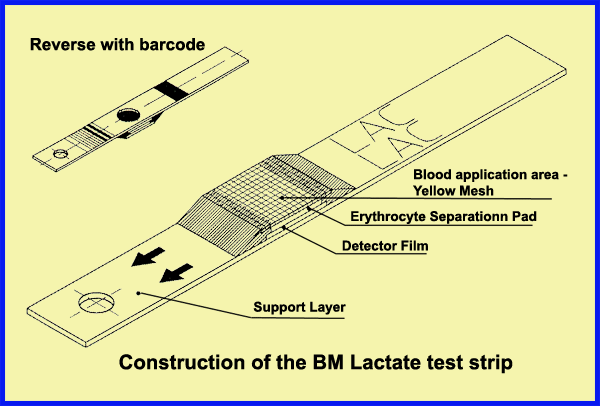
The following steps illustrate the mechanics of using the / Lactate hand-held Lactate Analyzer, and show how easy it is to use. The product is light-weight (about 4 oz) and fits in the palm of your hand. It is used with lactate strips that come in vials of 25 strips.
How to Use the / Lactate Analyzers
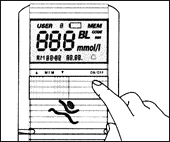 1. There is an off/on button on the meter. Press this button to
turn on the meter. The screen will initially flash the numbers 88.8.
1. There is an off/on button on the meter. Press this button to
turn on the meter. The screen will initially flash the numbers 88.8.
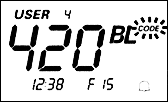 2. When the meter is turned on, a code number for the or
lactate strips is displayed. For example, suppose the number 420 appears
on the display. This indicates the meter is calibrated for strips from lot number
420. To change this number to reflect a new lot of strips you simply place a
coding strip into the meter. Every box of strips contains one of these coding
strips. Coding takes about 5 seconds.
2. When the meter is turned on, a code number for the or
lactate strips is displayed. For example, suppose the number 420 appears
on the display. This indicates the meter is calibrated for strips from lot number
420. To change this number to reflect a new lot of strips you simply place a
coding strip into the meter. Every box of strips contains one of these coding
strips. Coding takes about 5 seconds.
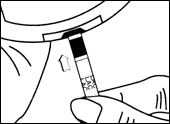 3. Take a new strip out of the vial and insert the strip into the slot
at the base of the meter. The machine will beep if the strip is ok and the code
number will remain on the display.
3. Take a new strip out of the vial and insert the strip into the slot
at the base of the meter. The machine will beep if the strip is ok and the code
number will remain on the display.
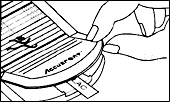 4. Open the flap at the base of the meter revealing the strip that
has just been inserted.
4. Open the flap at the base of the meter revealing the strip that
has just been inserted.
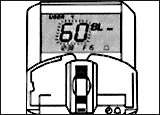 5. The display will now show 60 indicating it will take 60 seconds
to measure lactate in a sample, once the blood is applied to the strip and the
flap is closed.
5. The display will now show 60 indicating it will take 60 seconds
to measure lactate in a sample, once the blood is applied to the strip and the
flap is closed.
 6. Apply a drop of blood to the yellow pad in the middle of the strip.
The pad must be covered completely. A good sized blood drop will cover the strip
or about 20-25 micro liters of blood if you are using a lab measuring device.
This can also be done with the Reflotron applicator that is included with every
test package. The Reflotron applicator uses capillary tubes and makes this process
very easy.
6. Apply a drop of blood to the yellow pad in the middle of the strip.
The pad must be covered completely. A good sized blood drop will cover the strip
or about 20-25 micro liters of blood if you are using a lab measuring device.
This can also be done with the Reflotron applicator that is included with every
test package. The Reflotron applicator uses capillary tubes and makes this process
very easy.
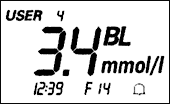 7. Close the flap immediately. The display will still show 60
seconds but will begin to count down to zero. When zero is reached the machine
will beep and then display the lactate value. In this example, the lactate
value is 3.4 mmol/l.
7. Close the flap immediately. The display will still show 60
seconds but will begin to count down to zero. When zero is reached the machine
will beep and then display the lactate value. In this example, the lactate
value is 3.4 mmol/l.
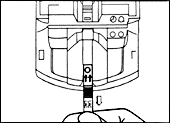 8. Open the flap and withdraw the test strip. Dispose of the test
strip properly.
8. Open the flap and withdraw the test strip. Dispose of the test
strip properly.
These steps must be accompanied by proper blood handling techniques!
There are additional steps necessary in setting up the meter for the first time. These take about 5 minutes and will not have to be repeated as long as the batteries in the meter are charged, or you want to change some settings.
While the machine is easy to use and quick, it is not a toy and should be treated like a lab instrument. The machine will provide valid blood lactate readings if proper technique is followed. Also it is vitally important to follow proper blood handling techniques and dispose of materials according to local health regulations.
|
경기도 안양시 동안구 호계 1동 555-9, 안양 국제유통상가 17동 127호 Tel 031-479-4211/2 이홈페이지는 인터넷 익스플로어러 1024*768 에 적당하게 사업자 등록 번호;114-21-61655, 업태; 제조, 종목;전자부품
|